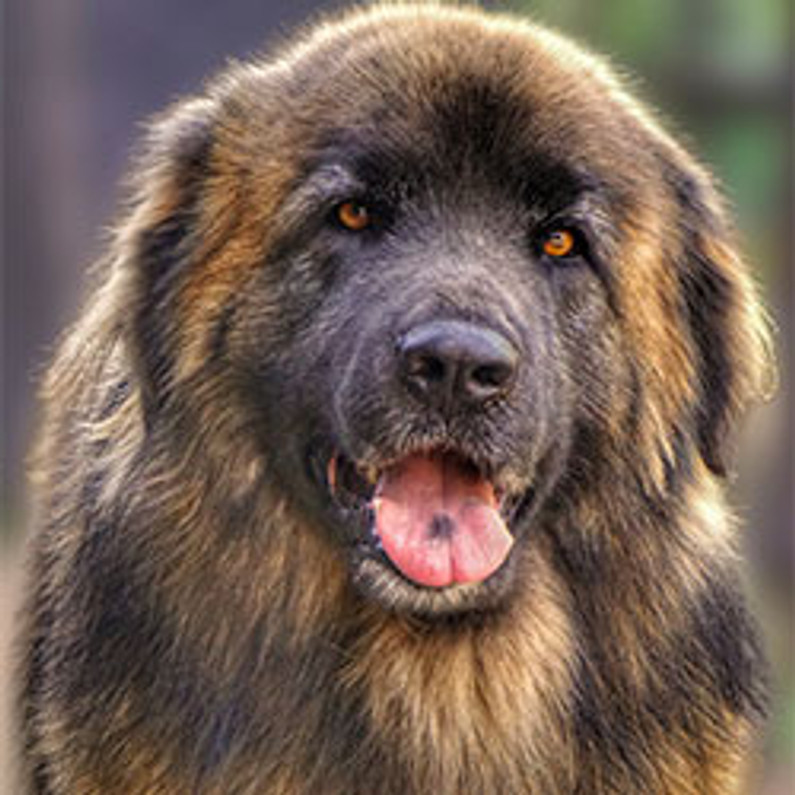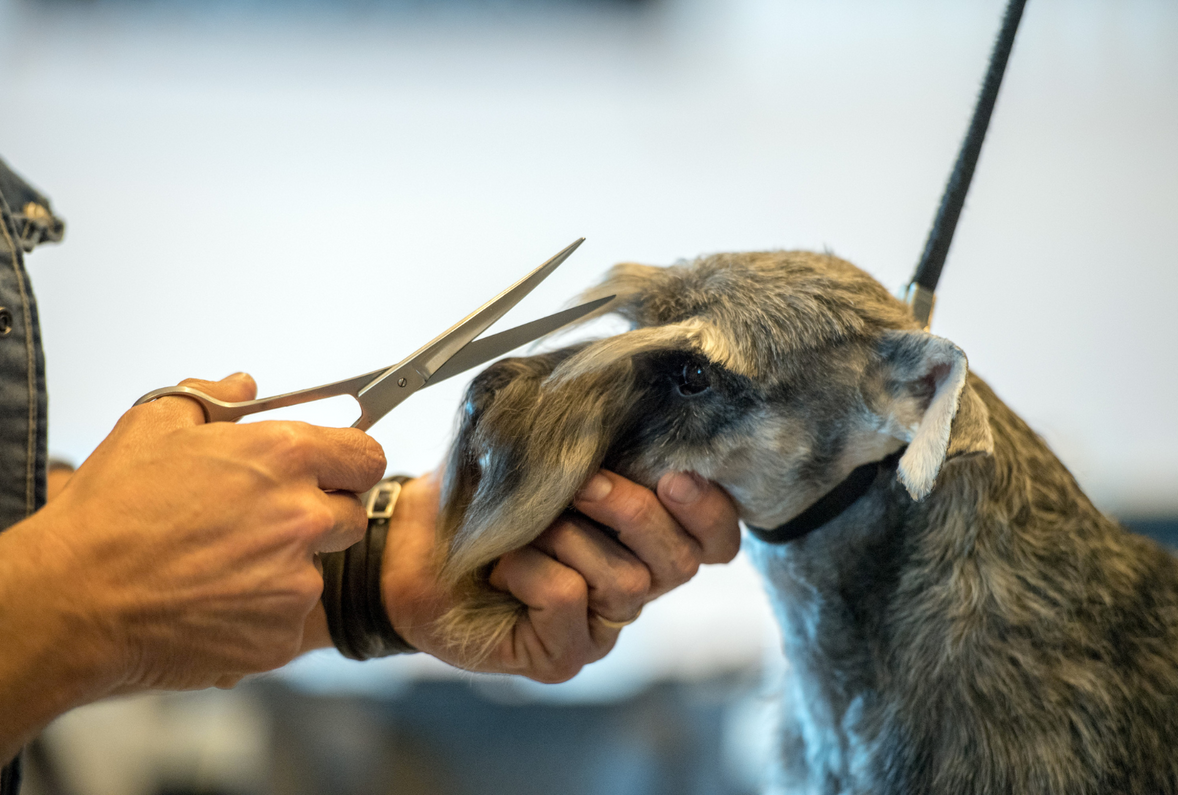Leonberger
In the 1830’s, a dog breeder and seller by the name of Heinrich Essig took credit for “creating” the Leonberger breed in the region of Wurttemberg, in Leonberg, Germany, by crossing a Landseer Newfoundland with a “barry” male from the Great St. Bernard Hospice and Monastery (which would later develop the St. Bernard). According to Essig, a Pyrenean Mountain Dog was later added, which resulted in very large dogs with long white coats, which were fashionable during that time.
Essig was a modern breeder’s nightmare. He was said to have raised several breeds of dogs in a commercial kennel and sold nearly 200 to 300 dogs each year. Other animals wandered the estate as well including ducks, chickens, turkeys, pigeon, deer and fox.
In 1846, the first dogs registered as Leonbergers were born. These dogs had many of the prized qualities of the breeds from which they were derived. Heinrich’s main goal, according to popular legend, was to create a breed that resembled a lion, the coat-of-arms animal of Leonberg. Many royal families owned and loved Leonbergers including Napoleon II of France, Empress Elizabeth of Austria, the Prince of Wales, and Italian King Umberto.
Before Heinrich’s idea of breeding a lion-like dog was even realized, according to Austrian historical findings from letters, journals and old paintings, dogs resembling the Leonberger had been in existence for approximately 300 years. It is believed that dogs with similar breed characteristics were known to exist as early as 1585 and probably even earlier. These dogs were kept to ward off sheep and cattle thieves. As it would be genetically impossible to attain the modern Leonberger coloring from the dogs that Essig claims to have used, it is probable that Alpine dogs in the regions of the Black Forest, which would accompany their owners to the market towns, may have been crossed with the long-coated, heavy-boned shepherds from the southern regions of Germany, which would account for the unique coloration of the Leonberger.
The modern look of the Leonberger with black masks and darker coats was developed during the 19th century by introducing other breeds. Much praised by their abilities in watch and draft work, by the end of the 19th century, Leonbergers were mainly kept as farm dogs.
Most Leonbergers were left to fend for themselves during WWI as many breeders and owners fled, or were killed. It was said that only 5 Leo’s survived WWI and were then bred until WWII when, again, war devastated the breed. In 1945, several Germans gathered the remaining Leonbergers and re-established the breed. The German Leonberger Club was formed in 1948.
Even though Leonbergers are listed in AKC stud books as early as 1887, in 1985 only 17 Leos were known to exist in the United States. It wasn’t until a couple by the name of Mary and Reiner Decher bred their Leo, who gave birth to 14 puppies, that the breed’s population dramatically increased, nearly doubling! The Decher’s and other enthusiasts owning German bred Leonbergers met in Denver, Colorado to establish the Leonberger Club of America. At that time, the club’s Code of Ethics, Rules and “Leo Letter” (the club’s official publication) were established. The next official meeting took place in Ontario, Canada at the club’s first national specialty show where the founding members worked out the guidelines for their new club which included electing officers and establishing plans as well as responsibilities. The club’s main goal was, and still is, to maintain the health and soundness of their beloved breed.
Regional clubs sanctioned by the Leonberger Club of America were formed as a result of the increasing popularity of the Leo. These clubs included the Northwest Leonberger Club, the Rocky Mountain Leonberger Club, the Northern and Southern California Leonberger Clubs and many more, whom organize their own specialty shows each year. 18 National clubs meet in Leonberg yearly to continue to preserve and protect the breed. Thanks to responsible and dedicated breeders ,as well as the efforts of all the LCA’s various committees, the future of the Leonberger in this country is on a “strong footing”, and in 2010, the Leonberger became able to compete as a member of the Working Group at American Kennel Club events.
The Leonberger, when well socialized and well trained, is self assured, insensitive to noise and submissive to family members. The typical Leo is an easy dog to live with, asking for no more than a bowl of food, water, regular exercise and his owner’s companionship. They are lively natured, brave, extremely intelligent, friendly and patient towards children, affectionate and well composed with passerby. Being highly trustworthy, Leonbergers who have been brought up around children in a family environment will be instinctively protective toward the children of the household; even with the most obnoxious children, Leos will be incredibly patient.

Leos are self-disciplined when obliging his family or property with protection. Leonbergers are often referred to as a “gentle giant”. Although all of this is true, they are not recommended for first time dog owners. When puppies, this breed may seem like little fluffy teddy bears, but within a matter of months, Leos grow exceedingly strong and very large. Training Leonbergers requires patience. Owners need to be firm, but calm, confident and consistent. They do not respond well to harsh training. They must be well socialized and continually trained from 8 weeks of age until they reach maturity at around 2 to 3 years of age. Leonbergers that are aggressive towards people, particularly children, do not represent the desired and typical temperament of the breed.
These giants are more active and more coordinated than many other large breeds. Leonbergers are steady, robust, loyal, playful and kind. This breed is very dexterous with their feet. Instead of stretching and using unnecessary energy, Leos will use their feet and claws to pull things towards themselves! Leos are a very social breed so make sure they are involved in family functions. If you can make space in your home, you’ll have a friend for life.
The Leonberger has a double coat that can vary in length and thickness, though most typically, they run at a medium length. Because they shed fur quite heavily, it is best to brush or comb your Leo daily or at least every other day to keep the coat free of tangles and mats. During the seasons, your Leo may require a little extra brushing to keep the moult under control. Ears and teeth should be cleaned regularly as with any other breed, however, baths should only be given when necessary.
Leonbergers do not require an extensive amount of exercise but should be taken on walks daily. They love to swim, hike and can be trained to pull carts or sleds, although this is not recommended for Leos before 18 months of age. Though they are too big for apartment living, Leonbergers are an inside dog, so make room on the couch! They need plenty of elbow room and cool climates. A large yard is always recommended for play time, with other animals or with you, but Leos love to be anywhere you are. Exercising your Leo will prevent problems that can occur due to boredom. A Leonberger is a large dog and capable of causing quite a bit of damage when they are bored. Because of their kindness, Leonbergers seem to have a natural ability to become great therapy dogs.
The lifespan of these giants is relatively short, averaging around 10 years. Common health problems include joint diseases and hip dysplasia, although they are highly controlled due to the effort of many breeders who actively screen their Leonbergers using x-rays and leave dysplastic specimens out of the gene pool, thereby reducing the risk of bone/joint problems. For more than 20 years, breeders belonging to the Leonberger Club of America, which issued Pedigrees for the Leonberger breed in America, adhered to many of the German breeding programs whereby member kennels may only choose to breed dogs that were certified as 3 generations free of hip dysplasia. Current incident rates of hip dysplasia are around 13%.
Though not common, Leonbergers can inherit or develop a number of diseases that range in their impact from mild to devastating including heart problems, Inherited Leonberger Paralysis/Polyneuropathy (ILPN), osteosarcoma, hemangiosarcoma, Osteochondrosis Dissecans, allergies, digestive disorders, cataracts, entropion/ectropion eyelids, Progressive Retinal Atrophy (PRA), perianal fistulas and thyroid disorders. Certain types of cancers are common as well as Addison’s Disease. Bloat is another serious condition that can be fatal quite quickly, although feeding smaller meals throughout the day is thought to help with this.
If you are looking for Gifts, Apparel and Jewelry featuring the Leonberger for yourself or a Leonberger lover on your gift list, visit Cherrybrook.com and select the Shop by Breed tab.
Recent Posts
-
Spring Into Action: Fun Exercise Ideas for Your Canine Companion
Spring Into Action: Fun Exercise Ideas for Your Canine Companion As the winter chill melts away …Mar 26th 2024 -
Understanding Dog Grooming Shears: Cutting Through the Noise
Understanding Dog Grooming Shears: Cutting Through the NoiseDog grooming, or in particular trimming, …Feb 5th 2024 -
Choosing the Perfect Bed for Your Dog: A Guide to all Types of Dog Beds
Types of Dog Beds: Choosing the Perfect Bed for Your DogEvery dog owner knows that a comfortable pla …Jan 26th 2024





